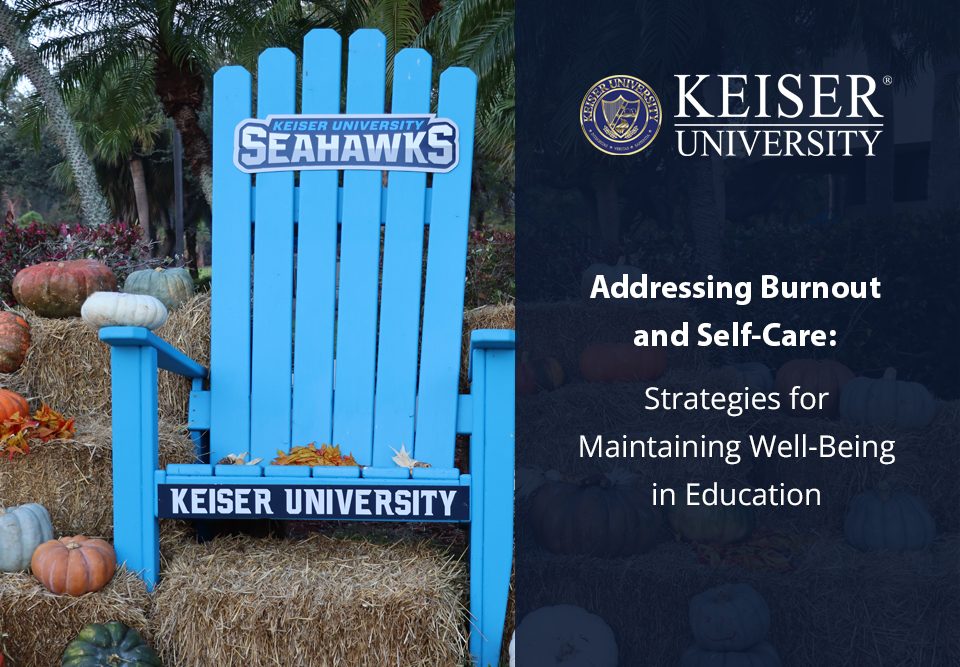Burnout is a widespread problem that impacts nearly every sector. Among the most vulnerable are educators, who face a variety of challenges that can feel overwhelming: jam-packed schedules, stressed students and limited resources.
The good news? While education burnout peaked during the pandemic, promising signs suggest that teachers are beginning to find their new normal.
Especially notable results stem from a 2023 RAND Corporation survey sponsored by the National Education Association and the American Federation of Teachers. This study reveals that teacher stress levels have returned to pre-pandemic levels, and that most teachers have access to mental health resources.
That said, there is still much progress to be made in addressing educator burnout, but research has uncovered several impactful strategies that individual teachers and administrators can implement. We’ve highlighted the most effective below, along with the signs of teacher burnout and the resources that today’s educators can leverage to prevent teacher fatigue and stress.
Understanding the Signs of Burnout
Burnout can manifest differently in various occupations, and often, what seem like clear signs of burnout in one sector may be less relevant in another. However, this term references a unique form of exhaustion, often prompted by prolonged stress and the ongoing sensation of feeling ‘swamped’ with work obligations.
What Is Burnout in Education?
Educator burnout represents a unique and emotionally fraught form of burnout in which teachers and other education professionals feel overwhelmed by the sheer magnitude of the workplace challenges they face. This may go beyond concerns regarding pay or scheduling. With education burnout, overarching cultural or occupational concerns loom large.
Teachers are heavily impacted by students, families and entire communities, and, as many see widespread struggles, they come to feel overwhelmed, detached or even cynical.
Understanding the Signs and Indicators of Burnout
Burnout is a multifaceted problem that can encompass a variety of problematic physical, mental, emotional or even spiritual concerns. Ideally, at-risk educators will be capable of recognizing these issues early on, as burnout is far easier to address in its initial stages.
Identifying Physical, Emotional and Behavioral Signs
Burnout manifests differently not only between sectors, but also from one educator to the next. Below, we’ve highlighted a few words and phrases that exemplify the numerous ways in which burnout can appear:
- Physical: Fatigue, insomnia, headaches, changes in appetite, frequent illness.
- Emotional: Feelings of inadequacy, irritability, cynicism, detachment or guilt.
- Behavioral: Procrastinating, withdrawing from social groups and events, lashing out at students or family members.
Recognizing the Impact of Burnout
Burnout can be devastating. It causes educators needless suffering at work and at home. This problem contains ripple effects, leaving an impact on students, coworkers, family members and the community.
Impact on Physical and Emotional Health
Burnout has a clear influence on a variety of physical mechanisms and can also lead to severe mental and emotional health concerns. In addition to the short-term symptoms highlighted above, the following long-term health issues are possible:
- Increased susceptibility to substance abuse.
- Greater likelihood of suicidal ideation.
- Elevated risk of cardiovascular disease.
Impact on Job Performance
In some situations, burnout may cause teachers to drop out of education altogether. Others remain in the field but may struggle to reach their full potential from a job performance standpoint. Issues may include:
- Emotional detachment makes it more difficult for teachers to build rapport and engage with students.
- Teachers dealing with burnout often struggle to implement effective classroom management strategies.
- Burnout is linked to cognitive impairment, thereby harming memory, problem-solving skills and verbal communication. All are critical for optimal job performance as an educator.
- Burnout limits motivation and may keep teachers from fully pursuing professional development or continuing education opportunities.
- Stress can be contagious, as research suggests that students in classrooms with stressed teachers show higher levels of cortisol.
Impact on Others
Poor job performance has an obvious impact on students, but these are by no means the only people who suffer when educators feel burned out. For example, some spouses of teachers report that burnout has negatively impacted their marriages. Meanwhile, burnout symptoms such as isolation make it more difficult to maintain a strong circle of friends.
This issue can quickly snowball in schools and in the community. For instance, if a student’s stress level increases in response to their teachers’ stress, they may be more likely to lash out at their own friends and family members.
Exploring the Causes of Burnout in Education
A variety of issues contribute to burnout in education. A wealth of these concerns were evident prior to COVID, although there is no denying that the pandemic had a huge influence on teaching and mental health. Commonly cited issues include:
Workload and Job Demands
It would be an understatement to refer to teaching as demanding. Teachers work long hours, which extend far beyond the ‘typical’ school day. In addition to classroom instruction, they must set aside time for lesson planning, conferences, correcting papers and so much more. Add volunteering or even part-time jobs to the mix, and it’s easy to see so many teachers lack downtime. Work-life balance is a consistently cited concern and may feel out of reach.
The emotional demands of education can also come into play. Just as students are impacted by stressed teachers, mental and behavioral concerns among children or adolescents can make even the most resilient educators feel worried, sad or even angry. Modern teaching involves a great deal of emotional labor, and this can be even more exhausting than the field’s already considerable time commitment.
Missing Support Systems and Safety Nets
Some educators find the aforementioned manageable, but this largely depends on the quality of their support systems. If they feel as if they’re forced to handle everything on their own, burnout is likely. Nevertheless, a little support can make a world of difference.
Implementing Self-Care Practices
Self-care is a huge buzzword these days, but the collective conception of this is often misguided; there’s more to self-care than bubble baths and massages. Instead, this concept references the general principle of teachers putting themselves first. Although accustomed to maintaining a spirit of giving, teachers need to remember that they also deserving of care.
Boundaries and Setting Realistic Expectations
Boundaries form the basis of effective self-care. Simply put, no relaxation or stress relief practices will be truly effective unless the source of the stress has been targeted. For several teachers, this means being willing to say “no.”
Specifically, teachers often feel obligated to take on additional tasks around the school, such as coaching extracurricular activities, participating in (or leading) committees or responding to emails at all hours of the day. Boundary-setting can alleviate some of this pressure while helping teachers achieve work-life balance.
Stress Relief Techniques
Setting boundaries can have a huge impact on long-term emotional health. But when stress rears its head, teachers also need coping mechanisms that will have an instant effect. Top options include:
- Meditation, yoga or deep breathing.
- Commiseration: group chats or phone calls with empathetic individuals.
- Affirmations or positive self-talk.
- Journaling, music or other forms of self-expression.
Healthy Habits
Lifestyle plays heavily into the concept of self-care. Research reveals that diet and exercise can have a huge impact on our well-being and, while it’s by no means easy for busy teachers to find time for cooking healthy meals or hitting the gym, even small changes can have a huge impact. Options for boosting physical health include:
Meal prepping healthy entrees to limit time spent cooking during the week.
Joining students for movement breaks during the day: jumping jacks, stretching, or even resistance band exercises.
Finding creative ways to get more steps when completing daily tasks within the school environment.
Seeking Support and Resources
If there’s a silver lining to the current issues with burnout it’s the widespread access to valuable resources. These can make all the difference when the demands of the education field start to seem overwhelming.
A number of resources are provided directly by employers, although community and family support are also frequently available. Teachers should not feel guilty or bashful about leveraging these opportunities.
Counseling Services and Mental Health Support
Counseling services have long been available to students, but now, an increased share of schools and districts provide similar opportunities for teachers. Per the aforementioned RAND study suggestions, mental healthcare services are especially common, although teachers may also enjoy access to employee assistance programs, wellness activities (such as meditation or yoga classes), peer support groups or encouragement to “use paid time off for mental health days.”
Connecting With Peers and Support
While some employers facilitate peer support groups, this is just one of many ways in which teachers can turn to fellow educators for insight or empathy. Teachers form their own support groups or other clubs that encourage them to build meaningful connections beyond the classroom.
Promoting a Culture of Well-Being in Education
After a solid support group has been established, it’s time to pay it forward. Teachers can safely assume that fellow educators are also feeling fatigued in addition to their students. Advocacy can tackle the underlying causes of teacher burnout to ensure that moving forward, teachers feel supported, respected and appreciated.
Implementing Policies and Practices
Teachers can be amazing advocates. Many are pleased to find that when they actively seek meaningful changes for the sector at large, they feel engaged and empowered. The National Education Association highlights several opportunities to shape policies, such as:
- Getting involved with union activities.
- Participating in marches, rallies or petitions.
- Participating in campaigns and elections.
- Speaking up during school board hearings.
Through career advancement, educators can also shape practices at the district or school level. These leadership roles call for extensive preparation, often in the form of a targeted educational leadership degree. This may include the Master of Science in Education, Leadership (MSEdL), or the Doctor of Philosophy in Educational Leadership, which both provide powerful insights into program evaluation, ethical decision-making and more.
Fostering a Supportive and Inclusive Environment
Today’s teachers actively seek to promote an inclusive classroom environment, but these efforts can also extend to schools at large. This might involve demonstrating empathy for fellow teachers and listening attentively as they share their concerns. Advocating for self-care is also important. The more teachers band together and show support for one another, the more resilient individual educators will feel. Again, this is another area in which educational leaders can make a world of difference.
Make a Difference in Education With Keiser
At Keiser University, we are committed to supporting educational professionals. We offer a variety of programs that encourage and empower the educational leaders of tomorrow. To note, our Doctor of Education includes Education Leadership and Curriculum Leadership opportunities, while our Education Specialist in Educational Leadership program provides an accessible pathway to career advancement.
Other exciting opportunities include the Master of Science in Education, Teaching and Learning (MSEd TL), the Education Specialist in Instructional Design and Theory and the Doctor of Philosophy in Instructional Design and Technology. Reach out today to learn more or feel free to chat with a graduate admissions counselor.






 The instructors at Keiser University impacted my life. They believed in my ability to become a great graphic designer, regardless of how I felt about my skills. KU helped to prepare me for the real world and got me to where I am today.
The instructors at Keiser University impacted my life. They believed in my ability to become a great graphic designer, regardless of how I felt about my skills. KU helped to prepare me for the real world and got me to where I am today.
